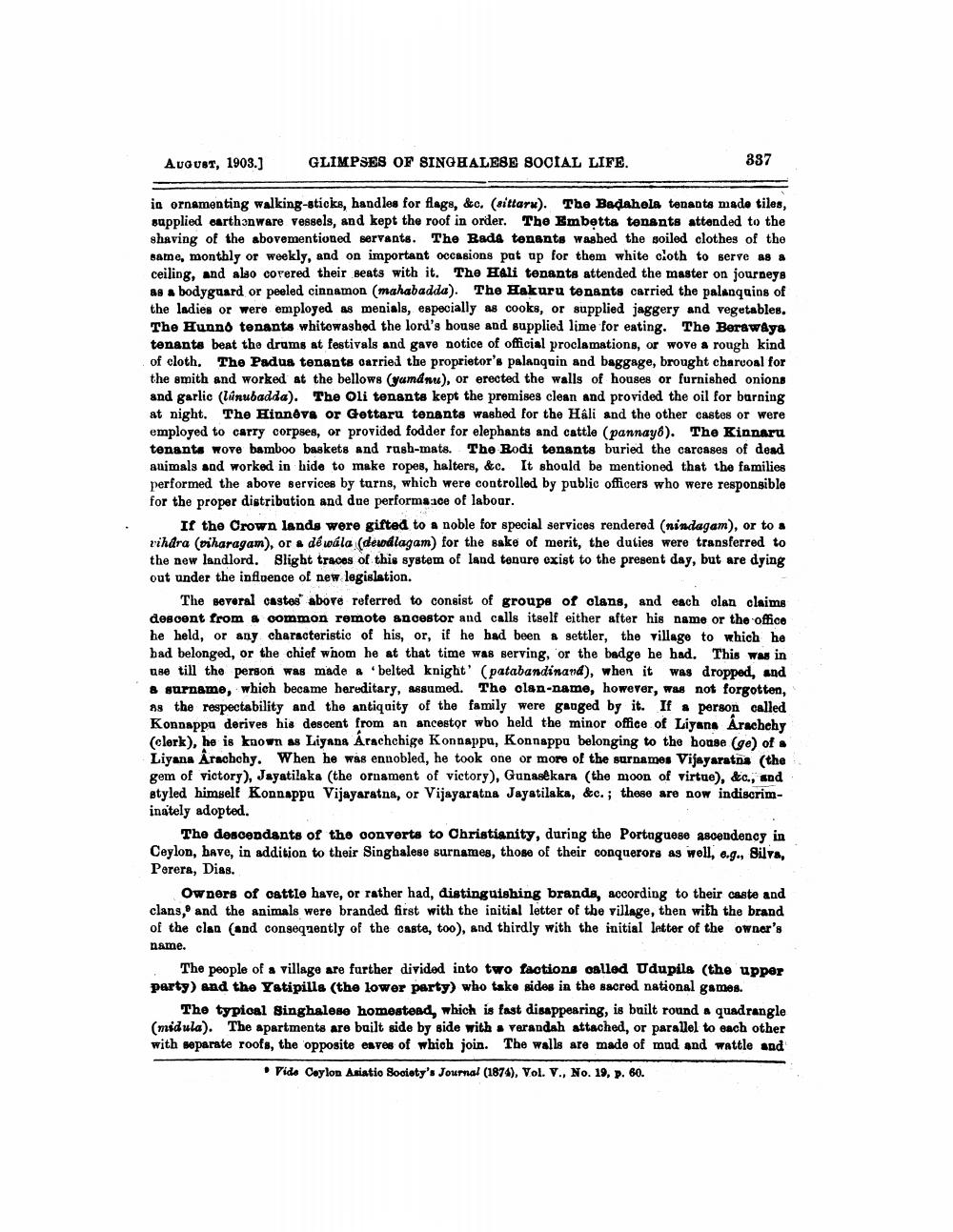________________
AUGUST, 1903.)
GLIMPSES OF SINGHALESE SOCIAL LIFE.
837
in ornamenting walking-sticks, handles for flags, &c. (sittaru). The Badahola tonants made tiles, supplied carthonware vessels, and kept the roof in order. The Embotta tenants attended to the shaving of the abovementioned servants. The Bade tenants washed the soiled clothes of the same, monthly or weekly, and on important occasions pat ap for them white cloth to serve as a ceiling, and also corered their seats with it. The Hali tenants attended the master on journeys as a bodyguard or peeled cinnamon (mahabadda). The Hakuru tenants carried the palanquins of the ladies or were employed as menials, especially as cooks, or supplied jaggery and vegetables. The Hunnd tenants whitewashed the lord's house and supplied lime for eating. The Berawaya tenants beat the drams at festivals and gave notice of official proclamations, or wove a rough kind of cloth. The Padus tenants carried the proprietor's palanquin and baggage, brought charcoal for the smith and worked at the bellows (yamdnu), or erected the walls of houses or furnished onions and garlic (lúnubadda). The Oli tenants kept the premises clean and provided the oil for barning at night. The Hinners or Gettaru tenants washed for the Hali and the other castes or were employed to carry corpses, or provided fodder for elephants and cattle (pannay). The Kinnaru tenants wove bamboo baskets and rusb-mate. The Bodi tenants buried the carcases of dead animals and worked in hide to make ropes, halters, &c. It should be mentioned that the families performed the above services by turns, which were controlled by public officers who were responsible for the proper distribution and due performa ace of labour.
If the Crown lands were gifted to a noble for special services rendered (nindagam), or to a vihdra (viharagam), or a dé wála (dewdlagam) for the sake of merit, the duties were transferred to the new landlord. Slight traces of this system of land tenure exist to the present day, but are dying out under the influence of new legislation.
The several castes" above referred to consist of groups of clans, and each olan claims descent from a common remote ancestor and calls itself either after his name or the office he held, or any characteristic of his, or, if he had been & gettler, the village to which he bad belonged, or the chief whom he at that time was serving, or the badge he had. This was in
se till the person was made a belted knight' (patabandinand), when it was dropped, and & surname, which became hereditary, assumed. The olan-Dame, however, was not forgotten, 83 the respectability and the antiquity of the family were ganged by it. If a person called Kondappa derives his descent from an ancestor who held the minor office of Liyana Aracbehy (clerk), he is known as Liyana Arachchige Konnappu, Konnappu belonging to the house (ge) of a Liyana Arachchy. When he was ennobled, he took one or more of the surnames Vijayaratna (the gem of victory), Jayatilaka (the ornament of victory), Gunasekara (the moon of virtue), &c., and styled himself Konnappu Vijayaratna, or Vijayaratna Jayatilaka, &c.; these are now indiscriminately adopted.
The descendants of the converts to Christianity, during the Portuguese ascendency in Ceylon, bave, in addition to their Singhalese surnames, those of their conquerors as well, e.g., Silva, Perera, Dias.
Owners of cattle have, or rather had, distinguishing brands, according to their caste and clans, and the animals were branded first with the initial letter of the village, then with the brand of the clan and consequently of the caste, too), and thirdly with the initial latter of the owner's name.
The people of a village are further divided into two factions oalled Udupils (the upper party) and the Yatipilla (the lower party) who take sides in the sacred national games.
The typical Singhalese homestead, which is fast disappearing, is built round a quadrangle (midula). The apartments are built side by side with a verandah attached, or parallel to each other with separate roofs, the opposite esves of which join. The walls are made of mud and wattle and
• Vida Caylon Aviatio Society's Journal (1874), Vol. V., No. 19, p. 60.




